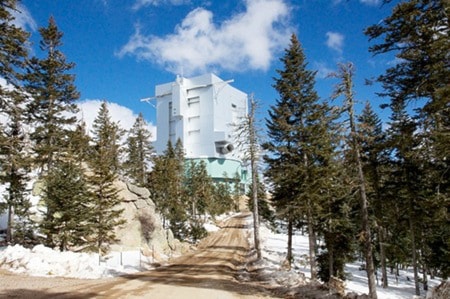Arizona sun traditionally lures Snowbirds south, but, increasing numbers are discovering what locals already know: the stars above are big and bright and attracting increasing numbers of career, and hobby, astronomers.
After months of overcast B.C. skies, a little sun, a little stargazing, a little desert history sounded out of this world to me. Last week I headed for Phoenix, and points south.
Many Arizona counties have implemented Dark Sky Ordinances designed to conserve cash and energy, and attract astronomers and researchers. One such place is Safford, home to MGIO, the Mount Graham International Observatory. Upon our arrival Mother Nature was in an uncooperative mood. But, when she finally unveiled the night sky it was undeniably impressive. Suddenly, I was acutely aware of how long it was since I’d seen such a brilliant extravaganza.
Minimizing artificial outdoor lighting in Phoenix, Flagstaff, and small southern centres, is proving that mysterious Dark Sky beauty inspires both scientists, tourists, and locals. “We retired here because of the clear skies,” hobby stargazers told me repeatedly. Is a backyard telescope standard desert equipment, I wondered? It seems so. Picture a real life, real time, sci-fi flick featuring flocks of Arizona residents emerging after dark hoping to be the first to spot a nebula (an interstellar gas and dust cloud), the birth of a new star, the demise of an old one, or simply being awed by a shooting star. I would be kept busy wishing on them all! The possibilities – based on the right conditions and equipment – are undeniably endless.
So, has preserving and promoting the Arizona night sky succeeded?
Apparently. It has lured the Vatican Advanced Technology Telescope to the strange desert-to-evergreen terrain atop Mount Graham, high above Safford. A few yards away looms the Large Binocular Telescope, one of the world’s most advanced telescopes housed in the constantly staffed Observatory.
And the Meteorite Collection at Arizona State University in Tempe contains the world’s largest university-based meteorite collection with over 1,600 separate meteorite falls is on display. Visits to this active global research centre are encouraged, and I would highly recommend it. There is no entry fee.
 Our tour was complex, and far exceeded all my elementary technical understanding of this massive installation, or the nearby Heinrich Herts Submillimeter Telescope. Suffice to say, though, I left with an increased awareness of the massive scope of the staggering size and complexity of the cosmos, plus a peculiar sense of having visited an alien world populated by invisible ‘day sleeper’ space travellers. It could also have been a touch lightheadedness – the Observatory altitude is 10,700 feet.
Our tour was complex, and far exceeded all my elementary technical understanding of this massive installation, or the nearby Heinrich Herts Submillimeter Telescope. Suffice to say, though, I left with an increased awareness of the massive scope of the staggering size and complexity of the cosmos, plus a peculiar sense of having visited an alien world populated by invisible ‘day sleeper’ space travellers. It could also have been a touch lightheadedness – the Observatory altitude is 10,700 feet.
[This plaque, at left, is in Latin at the door of the Vatican Observatory on Mount Graham. Photo Ursula Maxwell-Lewis]
“So, you believe in the Big Bang Theory?” I asked our well-versed, and clearly dedicated, guide. “Absolutely,” he replied firmly. The same sentiment was repeatedly voiced by hobbyists, and academics. Since no one was on duty at the Vatican Telescope Observatory, there was no way to inquire if VTO astronomers checked their faith at the door, or if they were just hedging their bets. That’s a discussion I’m sure I would have thoroughly enjoyed.
In the 1870s, the legendary Billy the Kid roamed these mountains, also known as ‘sky islands’, but times have changed. You’ll have to make reservations at the Eastern Arizona College’s Discovery Park Campus (call 928-428-6260) for weekend tours from mid May to mid November if weather permits.
On a more down-to-earth note, this is also the Salsa Trail, the tagline for a series of small town south-western Mexican-style restaurants.
A homemade chimichanga and salsa at the newly-renovated La Paloma Restaurant in nearby Solomon, and a visit with local Chamber of Commerce members, made me feel right at home.
There is also a local family-owned tortilla factory which is well patronized by locals.
For a real change of pace, an easy couple of hours drive will land you in historic Bisbee. This funky little town is composed of three sections, but it’s the old one that’s home to Brewery Gulch. It’s a long, dusty trip! A hill town populated by free-spirits and independent business folks, a glass-blowing merchant, and silver jewellery designer told me life there is good.
Discovering copper in 1880 turned this into a thriving little town, until the mine closed in 1975. Undaunted, the Queen Mine was turned into a tourist attraction that doesn’t disappoint.
Visitors ride 1,500 feet into the disused mine shaft on a little train with guides, many of whom were associated with the working mine. As always with such mines, it’s hard to imagine such labour-intensive work for men – and donkeys that worked underground until the darkness affected their eyes, and they had to be returned to the surface.
For more information:
Mt. Graham Int. Observatory: http://mgio.arizona.edu
Queen Mine Tour: www.queenminetour.com
Town of Bisbee: www.discoverbisbee.com
AZU (Tempe): www.asu.edu
– Ursula Maxwell-Lewis only scratches Arizona surfaces here. Look for caverns and more in her next southern travel tale. Follow her on Twitter @YouTravel
